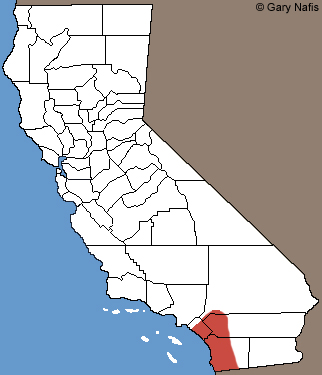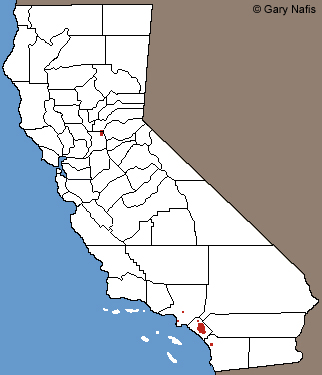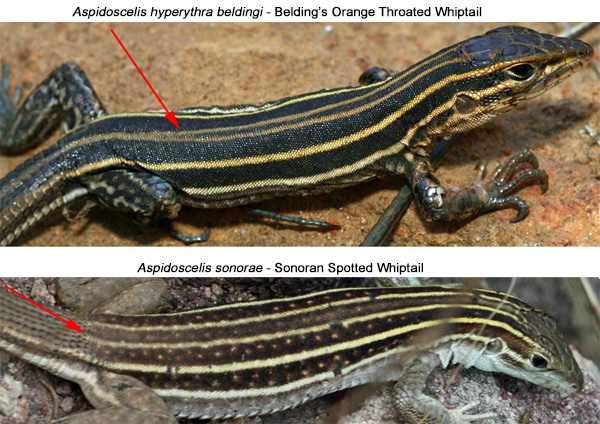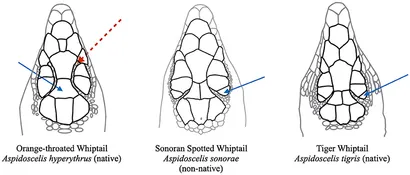Identifying California's Whiptail Lizards
Introduction
Before we begin, I feel obligated to declare that I am not an expert herpetologist (not yet at least). However, I am very passionate about our whiptails here in California, and I have done a fair share of observing, identifying, and reading on them, to the point where I at least feel confident enough to write this guide. I feel confident that it will contribute a little more than just the information on the amazing California Herps website from which this guide was inspired, at least when it comes to differentiating the native Orange-throated Whiptail from the invasive Sonoran Spotted Whiptail. If you are an expert and you notice any mistakes or have any information you would like to add, please feel free to comment or message me, and I will revise my guide accordingly. Alternatively, if you have a whiptail you observed in California and are unsure of the ID, feel free to tag me and I'll take a look and give an ID if I can. This guide will primarily use scientific names once they are introduced, using the taxonomy currently followed by iNaturalist.
Western Whiptail - Aspidoscelis tigris (Cnemidophorus tigris) - California Herps Page
It is typically quite easy to identify any Aspidoscelis tigris you find in California. Throughout much of their range, they are the only whiptail that occurs.

(Range map from California Herps shown above, © Gary Nafis. The map is colored by subspecies, with A. tigris tigris in red, A. tigris stejnegeri in blue, and A. tigris mundus in orange.)
Furthermore, their typical pattern is different than that of the other two whiptails found in California. They have a dark mottling pattern along their back, forming lines of broken up black stripes that contrast with the adjacent light stripes. This can be seen in my photos below (left observation link; right observation link).


Orange-throated Whiptail - Aspidoscelis hyperythrus (Cnemidophorus hyperythrus) - California Herps Page
Sonoran Spotted Whiptail - Aspidoscelis sonorae (Cnemidophorus sonorae) - California Herps Page
Identification starts to get more tricky when it comes to telling apart Aspidoscelis hyperythrus from Aspidoscelis sonorae. Range-wise, the native Aspidoscelis hyperythrus occupies a small region of Southern California, largely located in Orange County, Riverside County, and San Diego County. Invasive Aspidoscelis sonorae is found largely in Orange County, northern San Diego County, and a small population way up in Sacramento County.
Left: Range map of Aspidoscelis hyperythrus
Right: Range map of Aspidoscelis sonorae


(Range maps from California Herps shown above, © Gary Nafis.
***Please note that the Aspidoscelis sonorae map is slightly outdated, and that they have spread further into Southern California than is shown on the map).
Main Distinctions
Due to a somewhat similar appearance with cleanly defined light and dark stripes, Aspidoscelis hyperythrus can be hard to distinguish from Aspidoscelis sonorae in the areas in which they co-occur in Southern California. Listed below are the main things to look for when trying to tell them apart. Whiptails can often be high-energy and hard to photograph, but hopefully at least one of these is visible in your observation of interest.
1. Orange Throat Coloration: The most immediately obvious factor indicating that a whiptail is the native Aspidoscelis hyperythrus is its orange throat and chest. This can be seen well in this lovely photo by @nthorpe49 below (observation link). Females and juveniles may lack this characteristic (although I cannot seem to find much documentation as to what degree they may actually hold this characteristic).

2. Lack of Spots: Another way to tell the two apart is by the spots they may or may not have on their dark stripes. Aspidoscelis hyperythrus doesn't have light spots on its dark stripes. If your whiptail has spots like those shown below in great photos from @hleejones and @asmo_sw, it is an Aspidoscelis sonorae (left observation link; right observation link).


3. Paravertebral Stripe Merging: Another well-documented factor indicating the native Aspidoscelis hyperythrus is the merging of the paravertebral stripes. The paravertebral stripes are the two stripes running down the center of the lizard's back. For Aspidoscelis hyperythrus, these stripes merge together into a single stripe, extending down onto the tail. For invasive Aspidoscelis sonorae, these stripes stay parallel and then fade out on the tail.

(Diagram from California Herps shown above, © Gary Nafis)
4. Blue Tail (Juveniles): Telling apart juvenile whiptails can be even more tricky than telling apart adults, but one thing to look for is the tail color. Juvenile Aspidoscelis hyperythrus have a blue tail, as shown in the observation on the left by @llaves (observation link). Juvenile Aspidoscelis sonorae have a pinkish tail, as can be seen in the observation on the right by @julicard (observation link (also I really hope this location is wrong, and it isn't actually in LA County)). Additionally, while it is usually easy to tell by just their pattern, juvenile Aspidoscelis tigris also have a blue tail, so any juvenile whiptail without a blue tail in California is almost certainly invasive.


5. Scale Morphology: I just found out about this aspect doing a little extra research to make sure that I've accounted for all that I can account for. The information came from this paper in Frontiers in Conservation Science by Samuel Fisher, Robert N. Fisher, and Greg Pauly. These methods are likely not super necessary for most cases, as if the lizard can be seen close enough to see details of the scales, it is likely other indicators will be visible. That said, I think this below diagram from the paper is great and should be referenced if needed.

The most useful indicator here is the frontoparietal plate being undivided in Aspidoscelis hyperythrus, while being divided in Aspidoscelis sonorae (shown by the blue arrow on the leftmost lizard in the diagram). I think this is the most useful because it is the most likely to be visible due to the scale size, and it seems to hold true in all cases rather than just some. You are able to see the divided frontoparietal plate well if you zoom in on this Aspidoscelis sonorae observation by @mferr (observation link).

The diagram's other blue arrows on the middle and right lizards show additional supraocular scales which Aspidoscelis hyperythrus sometimes lacks, although I have trouble finding observations where this is easily visible. The trait indicated with the red dashed arrow on the left lizard shows that "circumorbital scales sometimes extend forward of the frontal-frontoparietal suture". This is similarly hard to see for most whiptail observations. These traits might help you ID a macro picture of the face of an Aspidoscelis hyperythrus that doesn't capture the rest of the lizard; however, for the most part, they are probably overkill for simply deciding on an ID.
Supporting Distinctions
Listed below are some supporting factors to help in differentiating Aspidoscelis hyperythrus from Aspidoscelis sonorae. I don't think these should be one's only evidence, but they can help boost the confidence of an ID based off the main distinctions listed above.
1. Urbanization Level: Aspidoscelis sonorae seems to adapt better to living in more urban/residential areas than Aspidoscelis hyperythrus. While Aspidoscelis sonorae like the one below observed by @itazura (observation link) make it into Irvine proper, one typically needs to get further towards the nearby mountains to observe Aspidoscelis hyperythrus. If identifying in the "Identify" tab in iNaturalist, you can see each species respective ranges, as well as dots for the observations of each species. This can help show how close by the nearest observation for either species would be to the location of your whiptail of interest. I think this can be greatly helpful in determining whether one thinks an area might be too developed to see our native Aspidoscelis hyperythrus.

2. Range: Similar to above, another useful aspect to look at when identifying is the range in which both species have currently been observed. This should not be all that one bases their ID off of, as Aspidoscelis sonorae unfortunately seems to expand their range year by year. However, say you are identifying in an area where Aspidoscelis hyperythrus is found, much further away from where Aspidoscelis sonorae has ever been observed. You can be confident that it is probably Aspidoscelis hyperythrus, as range expansions typically do not jump super far in one go.
3. Brightness of Paravertebral Stripes: This last distinction is not super well documented, but it is something that I've seen people reference, as well as something that I occasionally think about when doing identification. Please only use this as supporting evidence, as I cannot find rigorous documentation of this trait, it is somewhat variable in whiptails I've observed, and cameras can muck with this depending on the exposure. With that being said, the paravertebral stripes of Aspidoscelis hyperythrus tend to be more faded compared to the adjacent light stripes on either side of them, whereas the paravertebral stripes of Aspidoscelis sonorae tend to be more comparable intensity to the adjacent light stripes on either side of them. You can see this distinction in the observations below from @martianhiker (observation link) and @lcsaki (observation link).


Final Thoughts and Acknowledgements
If you actually read all the way here, thank you! I hope you learned something from it! I had a lot of fun making this post, regardless if anybody actually reads it, so time well spent I suppose. I'd like to thank Gary Nafis, whose California Herps website has been invaluable for me getting into herping in here at home in California, whose range maps and diagrams I have borrowed, and whose information provided the backbone of this guide. I'd like to thank all the observers of the whiptail pictures I featured in this post, as I still haven't been able to take such great photos of Aspidoscelis hyperythrus and Aspidoscelis sonorae in California. I'd also like to thank @gregpauly, who has helped me with many a reptile ID at this point and has helped me get to the point where I feel confident enough to share the knowledge I've attained. He also was one of the authors of the paper I referenced in the scale morphology section, alongside Samuel Fisher and Robert N. Fisher. Finally, I'd like to thank @alexb0000, @joesjoes20, @cwbarrows, and all the others that do whiptail ID in California, y'all have inspired me and helped me develop as an identifier, and I hope to continue seeing y'all in the ID section of various posts of California lizards.







Comentarios
Thank you for making this guide! I will certainly be referring to it when I see whiptails here in the future.
Thanks for creating the guide. I learned several useful tips that I plan to use in the field.
Thanks for the shout-out, this is an excellent write-up.
Well done!
:)
very helpful guide for a special californian creature :)
Agregar un comentario